
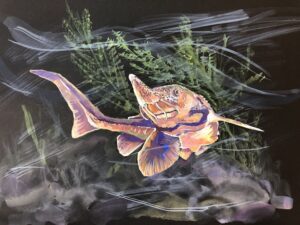 The full moon in August is traditionally referred to as the Sturgeon moon. Many of the names for the full moons each month, derive from native American and European sources. Often named after seasonal events or occurrences. In August, freshwater Sturgeon were at one time abundant and readily caught as a food source with several species providing caviar from their eggs. There are 28 species of this ancient fish, two of which were found in UK rivers and coastal waters, though sadly uncommon today and on the critically endangered list. Sturgeons were declared to be a royal fish under a statute dating back to 1324 by King Edward II of England, meaning that under the law of the UK, any sturgeon captured within the realm are personal property of the Monarch. They can reach 6 meters in length, maturing at around 12-16 years old, and living up to 100 years in total. They have a heterocercal caudal fin similar to those of sharks, are smooth-skinned, scaleless, and armoured with five lateral rows of bony plates called scutes. The long fringe like barbels which protrude from the sides of the mouth and under the chin are sensitive with numerous taste buds that are used for searching for food in murky water.
The full moon in August is traditionally referred to as the Sturgeon moon. Many of the names for the full moons each month, derive from native American and European sources. Often named after seasonal events or occurrences. In August, freshwater Sturgeon were at one time abundant and readily caught as a food source with several species providing caviar from their eggs. There are 28 species of this ancient fish, two of which were found in UK rivers and coastal waters, though sadly uncommon today and on the critically endangered list. Sturgeons were declared to be a royal fish under a statute dating back to 1324 by King Edward II of England, meaning that under the law of the UK, any sturgeon captured within the realm are personal property of the Monarch. They can reach 6 meters in length, maturing at around 12-16 years old, and living up to 100 years in total. They have a heterocercal caudal fin similar to those of sharks, are smooth-skinned, scaleless, and armoured with five lateral rows of bony plates called scutes. The long fringe like barbels which protrude from the sides of the mouth and under the chin are sensitive with numerous taste buds that are used for searching for food in murky water.
At first glance these fish have a green-grey colouring, but you can have fun with colour and explore some techniques using Winsor & Newton Designer Gouache to celebrate this spectacular fish as it emerges from the black background.
 The black watercolour surface enables the gouache colours to pop, and the opaque paint offers an even flat finish. The paint has a thick consistency straight from the tube, so a little water helps make the paint more blendable. A flat brush helps to build up solid blocks of colour.
The black watercolour surface enables the gouache colours to pop, and the opaque paint offers an even flat finish. The paint has a thick consistency straight from the tube, so a little water helps make the paint more blendable. A flat brush helps to build up solid blocks of colour.
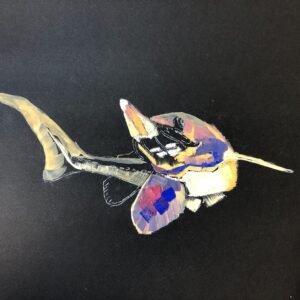 The colours can be built up in layers enhancing some of the colours in the body of the fish. Utilising the flat brush even further by creating stippling effects with the opaque paint.
The colours can be built up in layers enhancing some of the colours in the body of the fish. Utilising the flat brush even further by creating stippling effects with the opaque paint.
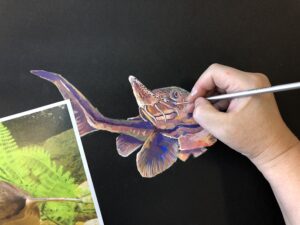 Using a smaller brush, you can add in the finer details of the sturgeons face, fins etc. Lighter colours can be added over darker colours, and built up to the desired effect.
Using a smaller brush, you can add in the finer details of the sturgeons face, fins etc. Lighter colours can be added over darker colours, and built up to the desired effect.
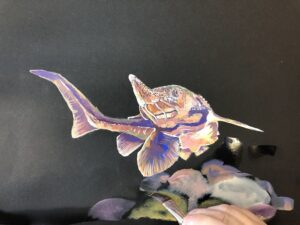 Into the background and a wet into wet technique is used to create a softer finish which helps to suggest rocks, gravel and sand. These are bottom feeding fish, eating worms, mussels and crabs. The surface around the bottom of the fish is wetted with a damp brush and wet gouache is added into the still wet surface. the colour spreads and creates softer shapes.
Into the background and a wet into wet technique is used to create a softer finish which helps to suggest rocks, gravel and sand. These are bottom feeding fish, eating worms, mussels and crabs. The surface around the bottom of the fish is wetted with a damp brush and wet gouache is added into the still wet surface. the colour spreads and creates softer shapes.
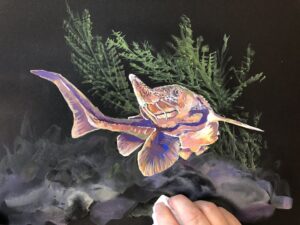 Gouache is a water-soluble paint and like watercolour is still soluble with water even when it has dried. These shapes can be altered and amended by lifting off some of the colour with a damp brush or some kitchen roll.
Gouache is a water-soluble paint and like watercolour is still soluble with water even when it has dried. These shapes can be altered and amended by lifting off some of the colour with a damp brush or some kitchen roll.
 This wet into wet technique can also be used into the background above the fish for some green water plants. When the surface has dried, additional fronds can be added over the softer the dry layer to create additional texture.
This wet into wet technique can also be used into the background above the fish for some green water plants. When the surface has dried, additional fronds can be added over the softer the dry layer to create additional texture.